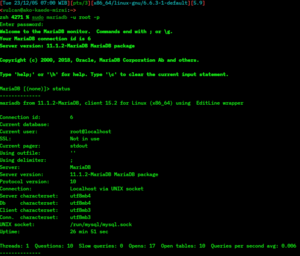MariaDB facts for kids
 |
|
 |
|
| Developer(s) | MariaDB plc, MariaDB Foundation |
|---|---|
| Initial release | 29 October 2009 |
| Stable release |
Lua error in Module:Wd at line 1575: attempt to index field 'wikibase' (a nil value). / Lua error in Module:Wd at line 1571: attempt to index field 'wikibase' (a nil value).
|
| Preview release | Lua error in Module:Wd at line 1575: attempt to index field 'wikibase' (a nil value). (Lua error in Module:Wd at line 1571: attempt to index field 'wikibase' (a nil value).) |
| Written in | C, C++, Perl, Bash |
| Operating system | Linux, Windows, macOS |
| Available in | English |
| Type | RDBMS |
| License | GPLv2, LGPLv2.1 (client libraries) |
MariaDB is a special kind of computer program that helps organize and manage large amounts of information. It's called a relational database management system (RDBMS). Think of it like a super-smart filing cabinet for digital data.
MariaDB was created by some of the original people who made another popular database program called MySQL. They started MariaDB because they were worried about MySQL's future after it was bought by a big company called Oracle Corporation in 2009. MariaDB was designed to stay free and open-source software, meaning anyone can use it, change it, and share it.
MariaDB works very much like MySQL. This means that many programs designed for MySQL can easily switch to using MariaDB instead. It also has new ways to store data, called storage engines, like Aria and ColumnStore.
MariaDB itself is free to use. However, the company behind it, MariaDB plc, makes money by creating other special products that work with MariaDB. In 2023, MariaDB plc started selling shares to the public. Then, in 2024, a company called K1 Investment Management bought all the shares and chose a new leader for MariaDB plc.
The main technology expert for MariaDB is Michael "Monty" Widenius. He was one of the people who started MySQL. MariaDB is named after his younger daughter, Maria. (MySQL was named after his other daughter, My!) The MariaDB logo is a sea lion. Monty Widenius chose it after seeing sea lions while snorkeling with his daughter in the Galápagos Islands.
Contents
MariaDB Server: How It Works
Keeping It Free
The MariaDB Foundation, which helps guide MariaDB's development, promises that "MariaDB Server will remain Free and Open Source Software licensed under GPLv2." This means it will always be available for everyone to use and improve, no matter what commercial companies do.
Version Numbers
For a while, MariaDB's version numbers were similar to MySQL's. For example, MariaDB 5.5 had all the features of MySQL 5.5. But as MariaDB added its own unique features, the developers decided to change the main version number. This was to show that MariaDB was growing and adding new things that MySQL didn't have.
Working with Other Programs
MariaDB is designed to be very similar to MySQL in how it connects with other computer programs. This means that most tools and applications that work with MySQL can also work with MariaDB. For example, some computer operating systems like Fedora and OpenBSD switched from using MySQL to MariaDB. They did this because they were concerned that MySQL was becoming less open for everyone to use freely.
However, MariaDB doesn't always have exact copies of every new feature from MySQL. Sometimes, MariaDB has different ways of doing things, or it might not have an equivalent feature yet. Even so, it's usually possible to switch from MySQL to MariaDB without too much trouble.
Who Uses MariaDB?
Many big companies and organizations use MariaDB to manage their data. Some well-known users include ServiceNow, DBS Bank, Google, Mozilla, and the Wikimedia Foundation (which runs Wikipedia!).
Also, many Linux and BSD operating systems include MariaDB. Some even use it as their main database program by default. This includes popular ones like Arch Linux, Debian, Fedora, and Red Hat Enterprise Linux.
MariaDB Foundation: The Guardians of MariaDB
The MariaDB Foundation was started in 2012. Its main job is to guide the development of MariaDB and make sure it stays free and open for everyone. The current CEO of the MariaDB Foundation is Anna Widenius. Kaj Arnö was the CEO from 2019 to 2025 and is now the Executive Chairman.
Supporters of the Foundation
The MariaDB Foundation gets support from many important sponsors. In January 2025, some of these sponsors included Amazon, Intel, MariaDB Corporation AB, and Google. Google even had one of its engineers work at the MariaDB Foundation in 2013. Amazon also helped with a big new feature called MariaDB Vector, which uses AI.
History of the Foundation
In December 2012, Michael Widenius, David Axmark, and Allan Larsson announced they would create the MariaDB Foundation. They wanted it to work like other successful open-source foundations.
The MariaDB Corporation AB was the first sponsor of the Foundation in 2014. They made agreements about who owned what and what each group's role would be. For example, "MariaDB" is a registered trademark of MariaDB Corporation AB, but the Foundation is allowed to use it. MariaDB Corporation AB was first called SkySQL Corporation Ab. They changed their name in 2014 to show that they were a main force behind developing MariaDB.
Simon Phipps was the CEO of the Foundation from 2013 to 2014. He left because he felt the company wasn't letting the Foundation be truly independent. After him, Otto Kekäläinen was CEO from 2015 to 2018, and Arjen Lentz briefly in 2018. Kaj Arnö became CEO in February 2019. Eric Herman is the current chairman of the board.
MariaDB Corporation AB: The Business Side
MariaDB Corporation AB was started in 2010 by several people, including Michael "Monty" Widenius. Their goal was to build a global business around MariaDB. The current CEO of MariaDB Corporation is Paul O'Brien.
MariaDB Corporation AB was formed when SkySQL Corporation Ab and Monty Program merged in 2013. They changed their name in 2014 to show their important role in developing MariaDB Server and providing support for it. In February 2022, MariaDB Corporation AB announced its plan to become a publicly traded company on the New York Stock Exchange (NYSE).
Products from MariaDB Corporation AB
MariaDB Corporation AB helps develop the free MariaDB Server. They also create special tools called database connectors. These connectors help different programming languages like C, C++, Java, and Python talk to the MariaDB database.
They also develop the MariaDB Enterprise Platform. This is a set of more powerful MariaDB products designed for big companies. It includes things like:
- MariaDB MaxScale: A smart tool that helps manage database traffic.
- MariaDB ColumnStore: A way to store data that's great for analyzing information quickly.
- MariaDB Xpand: A database that can handle huge amounts of transactions.
- MariaDB Enterprise Server: A stronger, more secure version of the free MariaDB server.
MariaDB Corporation used to offer the MariaDB Enterprise Platform as a cloud service called SkySQL. This meant you could use the database over the internet without installing it yourself.
SkySQL: A Cloud Service
SkySQL was a cloud service from MariaDB that became generally available in March 2020. It allowed users to access MariaDB databases over the internet, often through platforms like Google Cloud Platform.
SkySQL was designed to be a flexible database service. It combined different ways of storing and analyzing data. This allowed developers to use one database for many different tasks.
However, as part of a company reorganization, MariaDB stopped offering SkySQL as a product in October 2023. In December 2023, SkySQL became its own separate company, no longer part of MariaDB.
Investors in MariaDB Corporation AB
MariaDB Corporation AB has received a lot of money from investors to help it grow. They raised over $123 million in different funding rounds between 2012 and 2022. Big companies like Intel and Alibaba have invested in MariaDB Corporation. The European Investment Bank also invested a significant amount.
See also
 In Spanish: MariaDB para niños
In Spanish: MariaDB para niños
- Comparison of database administration tools
- Comparison of MySQL database engines
- Comparison of relational database management systems
- Multi-master replication
Images for kids



